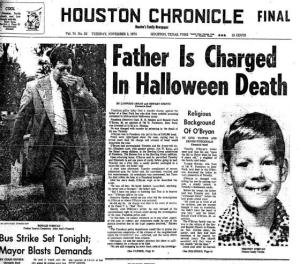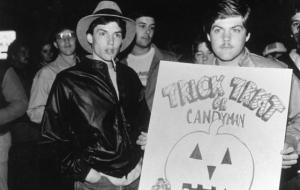If you grew up in the last half-century or so, the tradition of checking your Halloween candy after coming home from Trick or Treating was a commonplace event of your childhood.
There could be a razor blade stuck in your Taffy Apple or a loose wrapper on your peanut butter cup that may mean poison.
Like most things though, especially those connected to a holiday like Halloween, truth is often stranger (and sometimes scarier) than fiction.
The first question is: Has a child ever died from candy connected to the holiday of Halloween?
Yes.
That fact stated the truth behind the fear of a murderer targeting children through poisoned holiday sweets is a bit more complex and interesting...
Urban legends are odd things because they can grow.
Like living creatures, they pick up bits and pieces from a variety of sources. From Chinese Whispered eyewitness accounts to real events that are embellished and turned into fiction.
Fears about poisoned candy started after the Industrial Revolution, mostly due to products that were once made very local moving further away from the paying customer's eyes.
Sick children who had recently eaten candy propelled the myth, as they were thought to be victims of some sick and unscrupulous manufacturer of sweets.
In the late 19th and early twentieth century, the US Bureau of Chemistry began to test samples of candy. Besides an abundance of cheap corn syrup in many products, food coloring dye made from coal tar, and very small amounts of copper from cooking utensils, the candy was deemed to be poison-free.
Other incidents would later further the myth along such as:
- A dentist from California was charged with unlawful dispensing of drugs and outrage of public decency in 1959 when he tainted Halloween candy with a laxative.
- In 1964 a woman in Long Island believed that too many older teenagers were coming to her door for Trick or Treat so she handed out bags with items like steel wool pads, dog treats, and little 'dots' of any poison, which was clearly labeled as poison, She too was arrested and charged with child endangerment.
- The New York Times published an article on October, 28th, 1970 entitled: "Those Treats May Be Tricks," which even had a guide to what kind of poison or foreign objects maybe inside your children's holiday treats.
- Also in 1970, a five-year-old boy from Detroit named Kevin Toston apparently ate Halloween candy that contained the drug heroin. Although his case was reported as candy poisoning it ends up Toston got into a drug stash and the poisoning story was concocted to protect the family member the drugs belonged to.
A major boost to the legend took place when the Candy Man drove the legends to greater heights on Halloween Night in 1974.
The Man Who Killed Halloween:
Ronald Clark O'Bryan was an optician from Texas who had a wife and two children, an eight-year-old son named Timothy and a five-year-old daughter named Elizabeth. O'Bryan was also a deacon at his Baptist church.
On Halloween Night in 1974, O'Bryan took his son Timothy and daughter Elizabeth Trick or Treating in Pasadena, Texas, along with a neighbor and his two children.
Eventually, the group reached a house where no one would answer the door. Ronald O'Bryan stayed behind at this residence while the rest of the group moved on. O'Bryan rejoined the group a short time later, returning with five large straws of the powdered candy known as 'Pixy-Stixs,' which O'Bryan claimed were from the house that did not immediately answer when the group was together at the house.
O'Bryan gave two of the Pixy Stixs to each of his children and two to each of his neighbor's children as well. The fifth Pixy Stix was given to a ten-year-old boy O'Bryan knew from his Baptist church.

Before bed, Timothy ate some of his Halloween candy including one of the five Pixy Stix. Timothy complained about the taste of the candy to his father, drinking Kool-Aid to wash the powder down. Timothy also had to be helped to get the powdered candy out of its straw wrapper. Almost immediately after consuming the candy, he complained of stomach pains and began to convulse and vomit.
Timothy O'Bryan died in an ambulance on Halloween Night about an hour later.
Later tests would reveal that the five Pixy Stix were poisoned with potassium cyanide. The ends of the straw wrappers of each piece of candy had been cut off and the last two inches of the candy powder was replaced with poison and stapled shut.
Although none of the children in possession of the other four pieces of candy consumed them, the local area was swept by panic and many parents turned in or disposed of their children's Halloween candy as a precaution.
O'Bryan claimed to forget exactly which house those five particular candies had come from but soon his story began to fall apart.
Later O'Bryan would recall that the tainted Pixy Stix came from the house the group had stopped at where no one had answered the door. O'Bryan claimed a 'hairy' arm reached out from behind the front door of the house without turning the porch lights on and handed him the five pieces of candy.
Police soon dismissed this version of events because the man who owned the home in question worked as an air traffic controller and was not home on Halloween Night until around eleven P.M., and nearly two hundred co-workers could verify him being there all of Halloween Night.
It was also discovered that Ronald O'Bryan was deep in debt and was in danger of being unemployed. Records also showed that O'Bryan had taken out various life insurance policies on both his children totaling around sixty-thousand dollars between January and October of 1974.

A witness from a chemical shop was also found, who claimed O'Bryan came in shortly before Halloween to price packages of cyanide.
O'Bryan had also called to inquire about claiming the money on Timothy's insurance policy the day after Timothy died.
Ronald O'Bryan was eventually charged with one count of murder and four counts of attempted murder to which he pleaded not guilty. After the trial jury found him guilty in less than three hours of all charges and also sentenced him to death.
After a few legal battles that kept changing his execution dates (one missed date was on Halloween in 1982) Ronald O'Bryan was executed by lethal injection on March 31, 1984.
People gathered outside the prison he was executed at in Huntsville, Texas, carrying handmade signs denouncing the 'Man Who Killed Halloween,' also known as the 'Candy Man.'
Crowds chanted 'Trick or Treat' and threw candy at a small crowd of people who attended the gathering to protest the death penalty.
Copy Cats?
In almost every 'case' of poisoned Halloween candy known to exist, the motive is more about covering up crimes by adults rather than the sadistic monster-killing random children:
- In 1982 in Detroit a doctor who had an ill child as a patient claimed he had found traces of cyanide in the boy's system and panic about poisoned Halloween candy ensued. Later tests showed the doctor's initial claims were unfounded and no tainted candy was discovered.
- Washington D.C. residents in 1991 threw away a large amount of Halloween candy after a man died of heart failure right after eating a piece of his children's Halloween candy. The death was not related in any way to poisoning.
- A similar incident occurred a year earlier when a seven-year-old girl died of a heart attack while Trick or Treating. Again Halloween candy was the perceived culprit in some circles.
Partially the hysteria can be blamed on all the hype and paranoia the media has surrounded the subject with, telling parents to check or x-ray candy each Halloween and spreading stories of poisoning attacks on Trick or Treaters during the Cold War era and beyond.
Studies have been done on the subject over the years and despite the multiple stories, legends, and rumors, only two deaths directly related to Halloween candy were found. Those two deaths being Timothy O'Bryan and Kevin Toston in 1970, which were really an intentional murder and a cover-up of another crime, respectively.
In a survey of ten years of reports via a telephone hotline of Halloween candy tampering, the National Confectioners Association has yet to have a real report of any tampering with Halloween goodies.
One strange case that does seem frightening is a needle found by x-ray in a candy bar in 1988, for which no culprit or explanation was ever found.
Many other cases of poison on candy being discovered were later found to be the children themselves adding to the myth by putting the poisons on the candy themselves as a prank.
The legend continues today as recently Denver Police expressed fear at marijuana candy edibles being passed out in 2014.
Also in 2013 one twelve-year-old boy claimed to find a razor blade in a bag of M & M's:
However, despite the twisted tales and weird stories, this popular Halloween myth has brought to the limelight, I am going with the opinion William Breathes wrote when debating the recent 'pot candy' scare in Denver:
"This is just an updated version of the tired old story that fearmongering cops — and paranoid parents — have been pushing since the '70s. The idea is that some mythical Halloween Scrooge is out to hurt kids by giving away tainted candy. The thing is, the story isn't true; it's an urban legend."
Urban legend or not, the idea of poisoned Halloween Candy finding its way into a kids' Trick or Treat bag still goes on, as there was a report of a razor blade in a 'Mini-Twix' in 2019, and it was not the only report that year, although in all cases there appears there was no investigation into the reports.
So go ahead and eat that extra Hershey's bar in comfort and safety...possibly.
-Thomas Spychalski
(Via Snopes & Murderpedia)







No comments:
Post a Comment